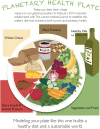Effects of an educational planetary plate graphic on meat consumption in a Stanford University dining hall: a randomized controlled trial
- PMID: 37749609
- PMCID: PMC10518909
- DOI: 10.1186/s40795-023-00764-3
Effects of an educational planetary plate graphic on meat consumption in a Stanford University dining hall: a randomized controlled trial
Abstract
Background: Assess the impact of an educational Planetary Health Plate (PHP) graphic on meat-related dietary choices of Stanford University dining hall patrons using a randomized controlled trial crossover design. All patrons entering the dining hall during study periods were enrolled as participants. Control, n = 631; PHP, n = 547.
Methods: Compare dietary behavior without signage to behavior while exposed to PHP during four equivalent dinner meals. The primary outcome was total meat-dish weight adjusted for the number of people entering the dining hall. Secondary outcomes included the number of meat-dish servings and average meat-dish serving weight. Analysis using T-tests, Poisson generalized linear model.
Results: Differences in total meat-dish weight, (1.54 kg; 95% Confidence Interval [CI] = -4.41,1.33; P = .19) and average meat-dish serving weight (0.03 kg; 95% CI = 0.00, 0.06; P = .07) between PHP and control patrons did not reach significance. The rate at which PHP patrons took meat was significantly lower (Incidence Rate Ratio 0.80; 95% CI = 0.71, 0.91; P < .001).
Conclusion: Exposure to an educational plate graphic decreased the proportion of patrons taking meat but had no impact on total meat consumption or meat-dish serving weight. Statistical methods used in this study may inform future investigations on dietary change in the dining hall setting. Further research on the role of educational signage in influencing dietary behavior is warranted, with an aim to improve human health and environmental sustainability.
Trial registration: ClinicalTrials.gov, NCT05565859, registered 4 October 2022.
Keywords: Behavior change; Direct behavioral outcome; Educational signage; Environmental sustainability; Planetary Health Plate.
© 2023. BioMed Central Ltd., part of Springer Nature.
Conflict of interest statement
The authors declare no competing interests.
Figures



Similar articles
-
Impact of trayless dining intervention on food choices of university students.Arch Public Health. 2018 Sep 24;76:61. doi: 10.1186/s13690-018-0301-5. eCollection 2018. Arch Public Health. 2018. PMID: 30258630 Free PMC article.
-
Using nutrition labeling as a potential tool for changing eating habits of university dining hall patrons.J Am Diet Assoc. 2008 Dec;108(12):2071-6. doi: 10.1016/j.jada.2008.09.009. J Am Diet Assoc. 2008. PMID: 19027411
-
Developing a digital photography-based method for dietary analysis in self-serve dining settings.Appetite. 2017 Jul 1;114:217-225. doi: 10.1016/j.appet.2017.03.050. Epub 2017 Apr 2. Appetite. 2017. PMID: 28377047
-
Single-Meal Nutrient Assessment by a Self-Administered, Electronic Exit Survey Compared with a Multipass Dietary Interview in University Undergraduates in an All-You-Care-to-Eat Campus Dining Hall.J Acad Nutr Diet. 2019 May;119(5):739-749. doi: 10.1016/j.jand.2019.01.020. J Acad Nutr Diet. 2019. PMID: 31029234
-
Nudging healthy college dining hall choices using behavioral economics.J Am Coll Health. 2021 Oct;69(7):697-703. doi: 10.1080/07448481.2019.1705842. Epub 2020 Feb 6. J Am Coll Health. 2021. PMID: 32027234
Cited by
-
Effect of a portion-size default nudge on meat consumption and diner satisfaction: controlled experiments in Stanford University dining halls.BMC Public Health. 2025 Apr 16;25(1):1434. doi: 10.1186/s12889-025-22495-9. BMC Public Health. 2025. PMID: 40241017 Free PMC article.
-
Measuring and shaping the nutritional environment via food sales logs: case studies of campus-wide food choice and a call to action.Front Nutr. 2024 Jun 4;11:1231070. doi: 10.3389/fnut.2024.1231070. eCollection 2024. Front Nutr. 2024. PMID: 38899323 Free PMC article.
References
Associated data
LinkOut - more resources
Full Text Sources
Medical
